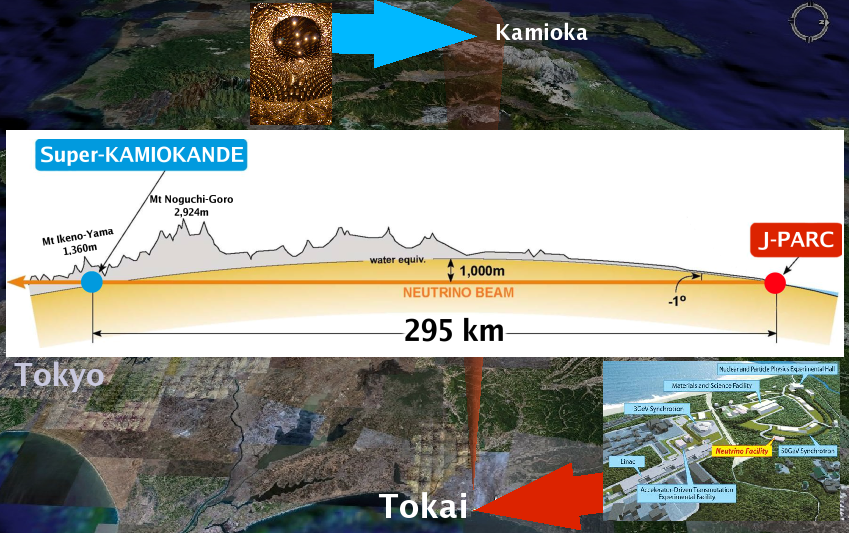|
Size: 3110
Comment:
|
Size: 2958
Comment:
|
| Deletions are marked like this. | Additions are marked like this. |
| Line 1: | Line 1: |
| #acl T2KAdminGroup:read,write,delete,revert T2KUKUsersGroup:read,write T2KUKProjectManagementAdminGroup:read,write,delete,revert #format html |
#acl T2KAdminGroup:read,write,delete,revert T2KUKPhysicsAndSoftwareAdminGroup:read,write,revert T2KUKProjectManagementAdminGroup:read,write,revert T2KUKUsersGroup:read,write All:read #format wiki = The Tokai-to-Kamioka Neutrino Oscillation Experiment = ~-(The [[FrontPage|Internal T2KUK Page]] | Collaborators can [[T2KUKPublicPage|Edit this page]])-~ == T2KUK Home Page == |
| Line 4: | Line 7: |
| <body> <div align="center"> <h1>The Tokai-to-Kamioka Neutrino Oscillation Experiment</h1> |
{{attachment:T2KOverview.png}} |
| Line 8: | Line 9: |
| <h2>UK Home Page</h2> | === UK Collaborating Institutes === ==== University Groups ==== * [[http://www.imperial.ac.uk/research/hep/research/T2K.htm|Imperial College London]] * [[http://www.lancs.ac.uk/depts/physics/|Lancaster University]] * [[http://hep.ph.liv.ac.uk/T2K|The University of Liverpool]] * [[http://www.physics.ox.ac.uk/PP/|The University of Oxford]] * [[http://hepwww.ph.qmul.ac.uk/t2k/|Queen Mary, University of London]] * [[http://www.hep.shef.ac.uk/research/t2k/|The University of Sheffield]] * [[http://www2.warwick.ac.uk/fac/sci/physics/research/epp/exp/t2k|Warwick University]] ==== STFC National Laboratories ==== * [[http://www.dl.ac.uk/DL/index.html|Daresbury Laboratory]] * [[http://www.stfc.ac.uk/About+STFC/48.aspx|Rutherford Appleton Laboratory]] |
| Line 10: | Line 22: |
| <p><img src="./T2KOverview.png"></p> | === The T2K Experiment === The T2K project, began data-taking in 2009, and has the primary goal of measuring for the first time a third type of neutrino mixing (related to the parameter theta,,13,,), which would result in the appearance of electron-type neutrinos from a beam of muon-type neutrinos after they have travelled 295 km across Japan. |
| Line 12: | Line 26: |
| <h3>UK Collaborating Institutes</h3><a href="http://www.cclrc.ac.uk/Activity/DL" alt="Daresbury Laboratory">Daresbury Laboratory</a><br> <a href="http://www.imperial.ac.uk/research/hep/research/T2K.htm" alt="Imperial College London">Imperial College London</a><br> <a href="http://www.lancs.ac.uk/depts/physics/" alt="Lancaster University">Lancaster University</a><br> <a href="http://hep.ph.liv.ac.uk/T2K" alt="The University of Liverpool">The University of Liverpool</a><br> <a href="http://hepwww.ph.qmul.ac.uk/t2k/" alt="Queen Mary, University of London">Queen Mary, University of London</a><br> <a href="http://www.cclrc.ac.uk/Activity/RAL" alt="Rutherford Appleton Laboratory">Rutherford Appleton Laboratory</a><br> <a href="http://www.shef.ac.uk/physics/research/pppa/research/t2k.php" alt="The University of Sheffield">The University of Sheffield</a><br> <a href="http://www2.warwick.ac.uk/fac/sci/physics/research/epp/exp/t2k" alt="Warwick University">Warwick University</a><br> |
T2K is the first of the “next generation” of oscillation experiment designed with very high intensity neutrino beams. The T2K “far detector” is the tried-and-tested Super-Kamiokande 50kt water Cherenkov detector, and the beam is optimised to enhance the oscillation signal and to suit the energies at which Super-Kamiokande can best measure the incoming neutrino type and energy. |
| Line 21: | Line 29: |
| <h3>The T2K Experiment</h3> </div> |
Both the beam and the way its neutrinos interact with water must be very well understood for an oscillation discovery to be made, and a “near detector” will be positioned a few hundred metres from the beam origin to make measurements on the beam before it starts oscillating. |
| Line 24: | Line 31: |
| <div align="left"> <p>The T2K project, due to begin data-taking in 2009, has the primary goal of measuring for the first time a third type of neutrino mixing, which would result in the appearance of electron-type neutrinos from a beam of muon-type neutrinos after they have travelled 295 km across Japan.</p> </div> |
=== Results and Publications === |
| Line 28: | Line 33: |
| <div align="left"> <p>T2K is the first of the “next generation” of oscillation experiment designed with very high intensity neutrino beams. The T2K “far detector” is the tried-and-tested Super-Kamiokande 50kt water Cherenkov detector, and the beam is optimised to enhance the oscillation signal and to suit the energies at which Super-Kamiokande can best measure the incoming neutrino type and energy.</p> |
==== First �,,e,, Appearance Result ==== |
| Line 31: | Line 35: |
| <p>Both the beam and the way its neutrinos interact with water must be very well understood for an oscillation discovery to be made, and a “near detector” will be positioned a few hundred metres from the beam origin to make measurements on the beam before it starts oscillating.</p> | === UK Involvement in T2K === |
| Line 33: | Line 37: |
| <p>UK institutes are involved in many aspects of T2K construction from the beam onwards, and in particular we are building a system of electromagnetic calorimeters for the near detector.</p> </div> |
* Near Detector Electromagnetic Calorimeters * J-PARC Proton Beam Target and Beamline Design * Near Detector Electronics and Data Acquisition * Photosensor Studies * Physics Studies and Offline Software === Proposal Documents === * [[attachment:T2KUKProposal.pdf]] (The Original Proposal, January 2006) * [[attachment:T2KUKSeedcornProposal.pdf]] (Seedcorn Funds Proposal, 2004) |
| Line 36: | Line 47: |
| <div align="center"> <h3>Other Links</h3><a href="http://www-nu.kek.jp/jhfnu/index_e.html" alt="Introduction to T2K at KEK">Introduction to T2K at KEK</a><br> <a href="http://www-sk.icrr.u-tokyo.ac.jp/sk/index-e.html" alt="Super-Kamiokande">Super-Kamiokande</a><br> <!-- <hr> <div align="left"> <a href="http://www.hep.ph.ic.ac.uk/~yoshiu">Yoshi.Uchida@imperial.ac.uk</a> </div> --> </div> </body> |
=== Other Links === * [[http://jnusrv01.kek.jp/public/t2k/|T2K at KEK]] * [[http://www.j-parc.jp|J-PARC]] * [[http://www-sk.icrr.u-tokyo.ac.jp/sk/index-e.html|Super-Kamiokande]] |
The Tokai-to-Kamioka Neutrino Oscillation Experiment
(The Internal T2KUK Page | Collaborators can Edit this page)
T2KUK Home Page

UK Collaborating Institutes
University Groups
STFC National Laboratories
The T2K Experiment
The T2K project, began data-taking in 2009, and has the primary goal of measuring for the first time a third type of neutrino mixing (related to the parameter theta13), which would result in the appearance of electron-type neutrinos from a beam of muon-type neutrinos after they have travelled 295 km across Japan.
T2K is the first of the “next generation” of oscillation experiment designed with very high intensity neutrino beams. The T2K “far detector” is the tried-and-tested Super-Kamiokande 50kt water Cherenkov detector, and the beam is optimised to enhance the oscillation signal and to suit the energies at which Super-Kamiokande can best measure the incoming neutrino type and energy.
Both the beam and the way its neutrinos interact with water must be very well understood for an oscillation discovery to be made, and a “near detector” will be positioned a few hundred metres from the beam origin to make measurements on the beam before it starts oscillating.
Results and Publications
First �,,e,, Appearance Result
UK Involvement in T2K
- Near Detector Electromagnetic Calorimeters
- J-PARC Proton Beam Target and Beamline Design
- Near Detector Electronics and Data Acquisition
- Photosensor Studies
- Physics Studies and Offline Software
Proposal Documents
T2KUKProposal.pdf (The Original Proposal, January 2006)
T2KUKSeedcornProposal.pdf (Seedcorn Funds Proposal, 2004)
